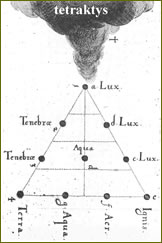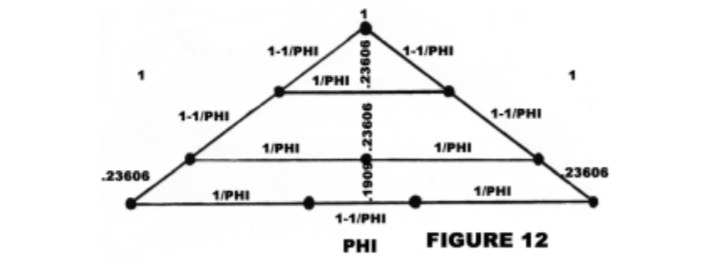“Some called the Tetraktys the great oath of the Pythagoreans, because they considered it the perfect number, or even because it is the principle of wholeness; among them is Philolaus.
“The number 10 is complete at 4” “To him that gave to our generation the Tetraktys, which contains the fount and root of all eternal nature”
“Arithmetic, geometric, and harmonics were the three principles by which the Divine Artifice proportioned out the world soul”
Number is the first principle, a thing which is undefined, incomprehensible, having in itself all numbers which could reach infinity in amount. And the first principle of numbers is in substance the first Monad, which is a male monad, begetting as a father all other numbers. Secondly, the Dyad is a female number, and the same is called by the arithmeticians even.
Thirdly, the Triad is a male number; this the arithmeticians have been wont to call odd. Finally, the Tetrad is a female number, and the same is called even because it is female. ….
Pythagoras said this sacred Tektractys is: `the spring having the roots of ever-flowing nature.’…. the four parts of the Decad, this perfect number, are called number, monad, power and cube. And the interweavings and minglings of these in the origin of growth are what naturally completes nascent number.
For when a power of a power; and a cube is multiplied on a cube, it is
the power of a cube; and when a cube is multiplied on a cube, the cube of a cube; thus all numbers, from which arise the genesis of
what arises, are seven:
- Number
- Monad
- Power
- Cube
- Power of a power
- Power of a cube
- Cube of a cube.
The Pythagoreans say that the triangle is the absolute principle of generation of begotten things, and of their form; that is why Timaeus says that the reasons of physical being, and of the regular formation of the elements are triangular; indeed, they have the three dimensions, in unity they gather the elements which in themselves are absolutely divided and changing; they are filled with the infinity characteristic of matter, and above the material beings they form bonds that indeed are frail. That is why triangles are bounded by straight lines and are [have] angles which unite the lines, and are their [ends].
The Pythagoreans considered the figure seven as the image and model of the divine order and harmony in nature. It was the number containing twice the sacred number three or the “triad,” to which the “one” or the divine monad was added: 3 + 1 + 3.
As the harmony of nature sounds on the key-board of space, between the seven planets, so the harmony of audible sound takes place on a smaller plan
within the musical scale of the ever-recurring seven tones. Hence, seven pipes in the syrinx of the god Pan (or Nature), their gradually diminishing proportion of shape representing the distance between the planets and between the latter and the earth–and, the sevenstringed lyre of Apollo. Consisting of a union between the number three the symbol of the divine triad with all and every people.
It’s been falsely asserted that the Pythagorean tetraktys is arranged evenly inside an equilateral triangle without meaning or proportion which would certainly be outside the meaning of the Pythagoreans that totality (Pan) underneath the monad is evenly distributed without proportional meaning and harmony. However if proportionally arranged inside the Pythagorean isosceles triangle, a near endless series of harmonies and ontological statements are demonstrated which most certainly prove that the very Pythagorean
triangle which “in conjoined triplet form the pentagram” is also one and the same triangle which is the skeleton for the tetraktys which
the Pythagoreans made their oath by.
In figure 12 above and 1 below, two things stand out: #1. That 1/Phi (matter-eidos-mimesis) have five representations, as does 1-
1/Phi (Soul, psyche)
but Phi to the power of -3 (.23606) has only four, two of which serve as basis for separation of the Eidos from the Monad, and matter from the Eidos, and two of which serve as the foundation for the hybrid intelligible, or Being. This is discussed elsewhere that the reason for the ‘missing .23606’ is in and choate to the Monad itself.
Since .23606 is the indefiniteness which perpetuates emanation from the Monad and from the Nous to Being. Privative agnosis having no principle to itself but being a privation of Subjective self-gnosis is therefore the ‘missing principle’ or “cause before cause” as mentioned by many a Greek philosopher as well as countless hundreds of Indian philosophers.
If figure 12 is examined, 1/Phi is strictly the domain of matter-eidos-mimesis, or all things empirical and visible (Plato 509D), whereas the periphery is the domain of all things ontological, intelligible and akin to the Monad, with Unity (1-1) as slopes, Monad as principle above, and the psyche-hybrid as base below.
The only exception where matter extrudes to the periphery is as being, where matter and shape are in union with the Soul as intelligible conglomeration, in this case forming Plotinus’ 3rd hypostasis, the Psyche tou pantos.
Looking at figure 3 below we see perfect harmony and proportion in Emanation, which is not found by placing the tetraktys inside
of an equilateral triangle.
Both proportional distances between all three hypostasis, their ontological peripheries and vertical separations are in perfect unison. There are 10 points in the tetraktys but only 7 sections, 2 for matter (one for visible and one for the
intelligible), 2 for mimesis (same as prior), one for the Soul, one for the Eidos, and lastly the atemporal ‘section’ of the Monad.
There is also only one point which lies within the Pythagorean triangle, and that is for the “shadows” of shapes and matter, even though the
eidos is within the triangle, its points (basis) are as per the Nous, or Unity on the periphery. That there are 5 sections of 1/Phi, 5 sections of 1-1/Phi, and 5 of Phi to the power of -3, or 5-5-5 coincides perfectly with the both
the pentagram and the harmonic means of the Decad itself being 5.
The ‘means’ between which the Monad and empirical intelligible Being find place by matter-mimesis, in whose union the Subjective is able to gain self-gnosis, by the objective unification of the Subjective principle as the Psyche tou Pantos. Matter and mimesis must precede in time that of the Psyche tou pantos, otherwise the 3rd hypostasis would find no conjunction with its “empirical harmonies” thereby creating the intelligible being; although of course the soul of man is everso precedent to the shadows of matter, but not temporally so as the consubstantial soul. That the Pythagoreans, Plato and most intelligent of all, Plotinus, were Trinitarians is certainly in no doubt.
Looking at Figure 13 below we see that the ontological center of the Psyche from the monad, or C, is the same dimension and angle as that of the empirical sectors of A and B. 1-1/Phi is to 1 as 1/Phi is to Phi. That there is perfect harmonic proportion between matter-mimesis and that of the Psyche is what both Pythagoras and Plato in the Timaeus speak of as the “Oneing” of “two unlikes”, being the “shadows” of matter and that of the Psyche in union as Phi, or Being.
Finally, looking at figures 9 and 5 below, the question might be raised as to why the 3rd line and base is .1909 from the 2nd base and from the Monad to the Eidos and from the Eidos to matter-mimesis the separation is .23606 as vertical separation. The answer lies in the proportioning out of Being that the two sloping bases of Phi are .23606 and its vertical is one half of the Psyche, or .1909, but that the two verticals of Eidos and matter-mimesis from the monad and from each other is also .23606 or Phi to the power of -3 three.
All section from Phi to the power of -3 thru to Phi cubed (4.23606) are covered in the tetraktys as laid out inside the Pythagorean triangle
of 1-1-Phi-1/Phi. Its utterly unthinkable that the Pythagorean tetraktys can be placed in anything but the Pythagorean 1-1-Phi triangle and not the
disproportional and unharmonious equilateral triangle as is commonly conceived.
If extended out into the pentagram further proportions are visible as to the tetraktys, namely to the effect that the 1-1/Phi becomes 1 to 1/Phi which becomes Phi as to the 4 elements and Aether (Psyche tou pantos). This as well as the ‘secret’ nature of the 5th Platonic solid, the dodecahedron, are but a part of the ‘unwritten doctrines’ which Plato does not speak about forthrightly for reasons that the Pythagoreans (of which Plato himself was) thought it unconscionable to discuss with the profane, uninitiated many folk, i.e. the common clod.









